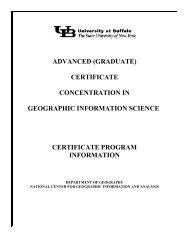Local Government GIS Demonstration Grant - NCGIA Buffalo
Local Government GIS Demonstration Grant - NCGIA Buffalo
Local Government GIS Demonstration Grant - NCGIA Buffalo
Create successful ePaper yourself
Turn your PDF publications into a flip-book with our unique Google optimized e-Paper software.
Manager's Overview 15<br />
<strong>GIS</strong> Database Construction<br />
Database construction (sometimes referred to as "database conversion") is the process of<br />
buildingthe digital database from the source data - maps and tabular files. This<br />
process would have beenplanned during the previous activity and the main emphasis here is<br />
management of the activity andquality assurance/quality control of the converted data. The<br />
conversion process is often "contracted-out" and involves large quantities of source maps and<br />
documents. Close and effective managementis the critical factor in successful data conversion.<br />
<strong>GIS</strong> System Integration<br />
Unlike many other computer applications, a <strong>GIS</strong> is not a "plug and play" type system. The<br />
severalcomponents of a <strong>GIS</strong> must be acquired according to well documented specifications. The<br />
databasemust be created in a careful and organized manner. Once all the individual<br />
components have beenacquired, they must be integrated and tested. Users must be introduced to<br />
the system, trained asnecessary, and provided with adequate assistance to begin use of the <strong>GIS</strong>.<br />
Parts of the <strong>GIS</strong> which may appear to work fine individually may not work properly when<br />
puttogether. The <strong>GIS</strong> system staff must resolve all the problems before users can access the <strong>GIS</strong>.<br />
<strong>GIS</strong> Application Development<br />
"Application" is a general term covering all things that "go on" in a <strong>GIS</strong>. First,<br />
there are "databaseapplications." These are all the functions needed to create, edit, build, and<br />
maintain the database,and are usually carried out by the <strong>GIS</strong> systems staff. Some users may have<br />
responsibility forupdating selected parts of the <strong>GIS</strong> database, however the entire database should<br />
be under the controlof a "database administrator." Other applications are termed "user<br />
applications." Contemporary<strong>GIS</strong>s provide many simple applications as part of the initial<br />
software package (e.g., map display,query, etc.). More complex applications, or ones<br />
unique to a particular user, must be developedusing a macro-programming language.<br />
Most <strong>GIS</strong>s have a macro-programming language for thispurpose (e.g., Arc Macro Language<br />
(AML) in ARC/INFO. and Avenue in ArcView). Theapplications needing development by<br />
the <strong>GIS</strong> systems staff will have been described during theNeeds Assessment on the <strong>GIS</strong><br />
Application forms.<br />
<strong>GIS</strong> System Use And Maintenance<br />
After having described the rather large task of creating a <strong>GIS</strong>, we can now say that use<br />
andmaintenance of the <strong>GIS</strong> and its database will likely require as much attention as was needed to<br />
initiallybuild it. Most <strong>GIS</strong> databases are very dynamic, changing almost daily, and users will<br />
immediatelythink of additional applications that they would like to have developed. Formal<br />
procedures forall the maintenance and updating activities need to be created and followed by the<br />
<strong>GIS</strong> system staffand by all users to ensure continued successful operation of the <strong>GIS</strong>.




